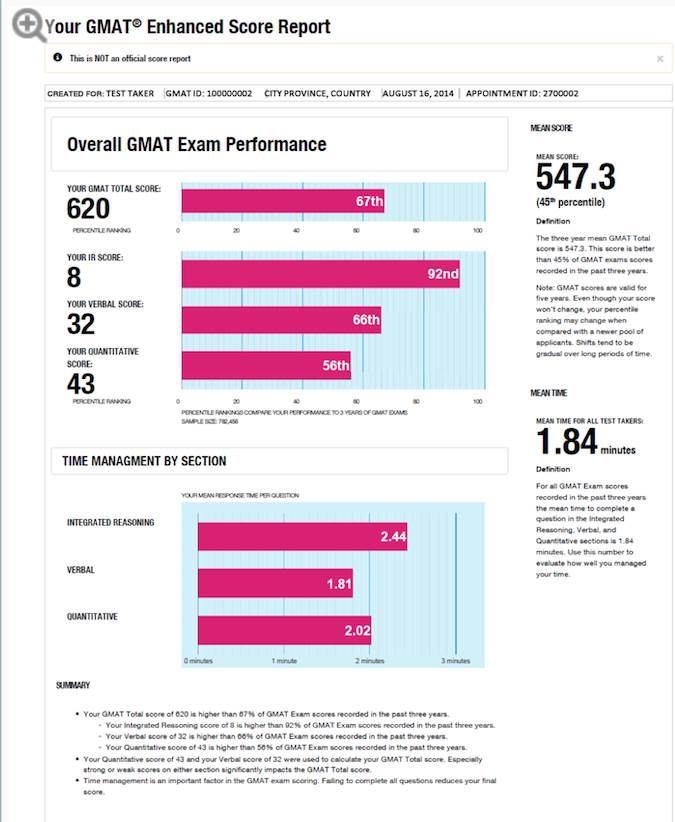Table of Contents
ToggleHere are the questions this article will answer:
What is the GMAT score based on? Which sections are taken into consideration? How are GMAT scores converted into percentiles? Read the article to find answers to all your questions. Before we understand the complex scoring method of the GMAT exam, it is important to understand that the score calculation is connected to the computer-adaptive nature of the GMAT.
What does Computer Adaptive mean in GMAT?
The GMAT is made up of four sections: a quantitative reasoning consisting of 31 questions, verbal reasoning consisting of 36 questions, integrated reasoning (IR) comprising of 12 questions, and analytical writing assessment (AWA) with 1 essay question. The GMAT score is based on Verbal and Quant sections only. These are also the only two sections of the GMAT that are computer-adaptive.
This means that the test driver that presents the GMAT selects the difficulty level of the next question based on the accuracy of your response to the previous question. In other words, the difficulty of the questions you see increases or decreases depending on whether you answer questions correctly or incorrectly.
Both quant and verbal sections of the GMAT start with medium-level questions. If you answer the first question correctly, the following question is a bit harder. If you give the wrong answer, the subsequent question is a bit easier. As you proceed with more questions, your accuracy determines whether the difficulty of the questions increases or decreases.
It is important to note that the adaptive nature of questions does not ‘cross-pollinate. This means that the performance in one section does not impact the difficulty level of the questions in the other section.
So, how does this question-level adaptivity impact your GMAT score? To accurately assess your quantitative and verbal abilities — and provide a score that accurately reflects those abilities — the GMAT uses IRT. Item Response Theory assesses responses to the questions based on both the number of questions answered correctly as well as the difficulty level of those questions.
GMAT Percentile Rankings Explained
| GMAT Total Score | GMAT Percentile Ranking |
|---|---|
| 760-800 | 99% |
| 750 | 98% |
| 740 | 97% |
| 730 | 96% |
| 720 | 94% |
| 710 | 91% |
| 700 | 88% |
| 690 | 85% |
| 680 | 82% |
| 670 | 80% |
| 660 | 77% |
| 650 | 73% |
| 640 | 67% |
| 630 | 65% |
| 620 | 62% |
| 610 | 58% |
| 600 | 54% |
Here are the key points you need to know about the GMAT percentile rankings:
- The scorecard that you receive on completing the GMAT exam contains 5 different scores: an individual score for Quant, Verbal, IR, and AWA, and your total GMAT score. Scores of the Integrated Reasoning and Analytical Writing Assessment sections are not considered in the final score.
- The verbal and quant sections fall within the 6 to 51 score range, giving a total score between 200 and 800. Though there are 5 additional questions in the Verbal section of the GMAT than in the Quant section (36 vs. 31, respectively), both Quant and Verbal performances are given equal weightage in calculating your total GMAT score.
- GMAT percentile rankings are based on the test scores of GMAT test-takers over 3 years. Each score corresponds to a certain ranking based on the data compiled by GMAC. These rankings tell you how your scores compare with those of your competition. For example, if you score 48 on the Quant section, the score chart below puts you in the 99th percentile. This indicates that you scored better than 99% of all GMAT candidates worldwide.
- The three-year data ensures that percentile rankings change over time. For instance, if a score of 730 puts a candidate in the 96th percentile today, it means that he/she scored more than 96% of all test-takers in the world in the past 3 years. But if in the subsequent three years more GMAT takers score 730, it may no longer put the candidate in the 96th percentile. Conversely, if fewer people achieve 730, your percentile ranking would increase. Thus, while the total score will remain the same, depending on the performance of your peers, your percentile ranking will vary.
- While the verbal and quant sections have the same score range, the percentile rank associated with those scores is different. The same score of 49 on the GMAT will put you in the 99th percentile in the verbal section and 74th in the quant. This is because, as mentioned above, the rankings depend on the performance of other test-takers. Based on the ranking table, it can be surmised that more GMAT test-takers score 49 on the quant section of GMAT than on the verbal section.
| Verbal Score | Verbal Percentile Ranking | Quant Score | Quant Percentile Ranking | IR Score | IR Percentile Ranking | AWA Score | AWA Percentile Ranking |
|---|---|---|---|---|---|---|---|
| 51 | 99% | 51 | 97% | 8 | 90% | 6 | 88% |
| 50 | 99% | 50 | 87% | 7 | 79% | 5.5 | 81% |
| 49 | 99% | 49 | 74% | 6 | 64% | 5 | 57% |
| 48 | 99% | 48 | 67% | 5 | 48% | 4.5 | 47% |
| 47 | 99% | 47 | 59% | 4 | 31% | 4 | 18% |
| 46 | 99% | 46 | 56% | 3 | 18% | 3.5 | 12% |
| 45 | 99% | 45 | 53% | 2 | 8% | 3 | 4% |
| 44 | 98% | 44 | 47% | 1 | 0% | 2.5 | 3% |
| 42 | 96% | 43 | 44% | 2 | 1% | ||
| 41 | 94% | 42 | 39% | 1.5 | 1% | ||
| 40 | 90% | 41 | 37% | 1 | 1% | ||
| 39 | 88% | 40 | 35% | 0 | 0% | ||
| 38 | 84% | 39 | 31% | ||||
| 37 | 82% | 38 | 29% | ||||
| 36 | 80% | 37 | 28% | ||||
| 35 | 75% | 36 | 25% | ||||
| 34 | 70% | 35 | 22% | ||||
| 33 | 68% | 34 | 21% | ||||
| 32 | 65% | 33 | 20% | ||||
| 31 | 60% | 32 | 17% | ||||
| 30 | 58% | 31 | 15% | ||||
| 29 | 55% | 30 | 15% | ||||
| 28 | 50% | 29 | 13% | ||||
| 27 | 45% | 28 | 12% | ||||
| 26 | 42% | 27 | 10% | ||||
| 25 | 38% | 26 | 10% | ||||
| 24 | 35% | 25 | 8% | ||||
| 23 | 31% | 24 | 8% | ||||
| 22 | 29% | 23 | 7% | ||||
| 21 | 25% | 22 | 6% | ||||
| 20 | 22% | 21 | 5% | ||||
| 19 | 18% | 20 | 5% | ||||
| 18 | 17% | 19 | 4% | ||||
| 17 | 14% | 18 | 4% | ||||
| 16 | 11% | 17 | 3% | ||||
| 15 | 9% | 16 | 3% | ||||
| 14 | 8% | 14 | 3% | ||||
| 13 | 6% | 13 | 2% | ||||
| 12 | 4% | 12 | 2% | ||||
| 11 | 3% | 11 | 1% | ||||
| 10 | 2% | 10 | 1% | ||||
| 9 | 1% | 9 | 1% | ||||
| 8 | 1% | 8 | 1% | ||||
| 7 | 1% | 7 | 1% |
Calculation of the GMAT Score
- Unlike the rankings, the GMAT score remains constant over the years. Once the candidate completes the GMAT exam, the system generates a quant, verbal, and a total score. The total score is based on the overall performance on all the non-experimental questions that appeared in the Quant and Verbal sections.
- Several experimental questions are incorporated in the quant and verbal questions, which don’t contribute to your score and are used for GMAC’s research purposes.
- However, the three scores mentioned above are not exact representations of the individual’s performance. Instead, a score represents a range of test performance. For instance, a candidate could get 19 or 21 Quant questions correct and still score Q47.
- Similarly, a verbal score of 38 shows that the level of performance of any two candidates is similar, but not necessarily the same. Simply put, a candidate who scored V38 may have performed at the low, middle, or top end of the range of performance that resulted in a score of V38. It is because of this feature of the GMAT scoring system that two people who achieve the same scores on the quant and verbal sections may receive different Total Scores.
- Here is an example:
To generate the total score of an individual who scored Q48 and V40, the computer does not use these two figures. Instead, it uses the individual’s actual performance in the two sections. The candidate may have scored Q48 with 24 questions correct in the quant section and V40 with 30 questions accurately answered in the verbal section. In that case, the total score would be dependent on the 24 and 30 correct questions in quant and verbal respectively, coming to likely a score of 720.
It may also happen that the candidate got the same section scores with 23 accurate answers in quant and 28 in verbal. In that instance, the total score would be formulated based on the 23 and 28 correct answers in quant and verbal to arrive at 710.
Thus, the test-taker would end up securing the same sectional scores despite a different number of accurate answers.

- The total score can also vary despite the same section scores because the GMAT score takes both the number of accurate answers and the difficulty level into consideration.
- The Integrated Reasoning section is in the range 1 to 8. The marks are not added to your GMAT Total Score. Your Integrated Reasoning score is, however, associated with a percentile ranking.
The Analytical Writing Assessment is scored on a scale of 0 to 6 and is not factored into the GMAT Total Score. The AWA score is not included in the unofficial GMAT score report. This is because the section is graded by both a computer and a person. The external examiner scores the essay using whole points from 0 to 6, and the computer algorithm scores in half-point increments from 0 to 6. Then, the two scores are averaged to produce your final score. If there is a large disparity between the human and computer score, a second human evaluates your essay, and the score may be adjusted accordingly.
Want to know how to calculate your ideal GMAT score? Read What is a Good GMAT Score for YOU?




